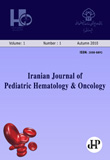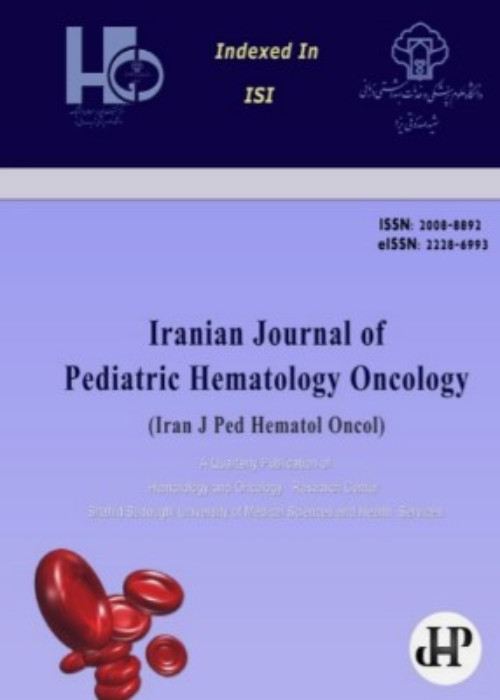فهرست مطالب

Iranian Journal of Pediatric Hematology and Oncology
Volume:6 Issue: 3, Summer 2016
- تاریخ انتشار: 1395/06/27
- تعداد عناوین: 8
-
-
Pages 142-148BackgroundAbdominal tumors are still a diagnostic problem in children. This study was conducted to assess the presentation and types of childhood intra abdominal tumors in children in Shiraz.Materials And MethodsParticipants of this historical cohort study consisted of 298 children aged between 1.5 months to 15 years old who were diagnosed with abdominal mass between March 2003 and March 2013. All patients referred to pediatric surgery wards of Namazi hospital affiliated to Shiraz University of Medical Sciences, Shiraz, Iran. Data extracted by checklist included patients demographic data, type of malignancy, signs and symptoms at the time of presentation and duration of signs and symptoms.ResultsThe majority of tumors were retroperitoneal followed by intra-peritoneal and pelvic masses. Wilms tumor was the most common tumor constituting 34% of all cases followed by neuroblastoma (24.7%), and non-Hodgkin lymphoma (12.7%). The most common signs and symptoms were abdominal pain (39.5%), abdominal distention (34.2%), palpable mass (27.5%), weight loss (19.4%), fever (16.7%), and vomiting (10.7%).ConclusionBetter understanding of signs and symptoms of abdominal masses can facilitate early diagnosis and proper treatment of malignant abdominal tumors in children.Keywords: Abdominal neoplasm, Pediatric, Peritoneal neoplasm, Retroperitoneal neoplasm
-
Pages 149-156Bakcground: The aim of ITP treatment is to prevent intracranial hemorrhage and increase the platelet count rapidly. This study was conducted with the objective of comparing the efficacy of anti-D immunoglobulin (Ig) with dexamethasone in treating childhood ITP.Materials And MethodsIn this randomized prospective control trial, 20 ITP patients (Platelet countResultsIn this study, 20 patients [11 girls (55%) and 9 boys (45%)] with the mean age of 5.6±4 years were enrolled. From the total number, 13 (65%) were younger than 5 years old, 4 (20%) aged between 5 and 10, and 3 (15%) were older than 10. There was no significant difference between the two groups regarding sex and age. In both groups the most common symptom was cutaneous manifestations (purpura, ecchymoses) (63.6% vs. 36.4% p=0.325). At enrolment time, the mean disease duration was 28±21 months, ranging from 5 to 132 months. Out of 20 patients, 9 (45%) suffered from chronic ITP, and 11 (55%) were in persistent phase of the disease. No significant difference was observed between the two groups regarding the frequency of chronic and persistent cases (p=0.370). Similarly, the follow-up platelet count four months after the treatment showed no significant difference between the two groups (p=0.241).ConclusionThe findings of this study did not confirm the priority of dexamethasone over anti-D Ig. The hemolytic side effects of anti-D were negligible compared to dexamethasone.Keywords: Dexamethasone, Idiopathic, Purpura, RHO(D) antibody, Thrombocytopenic
-
Pages 157-165BackgroundSodium bicarbonate serum therapy is used for compensation bicarbonate lost and increasing blood pH in metabolic acidosis caused by severe anemia in patient with glucose-6-phosphate dehydrogenase (G6PD) deficiency. The aim of present study was comparison the effect of serum therapy using two different serums (serum with bicarbonate and without bicarbonate) on some renal and hematologic factors and their side effects in patients with hemolysis caused by G6PD deficiency.Materials And MethodsIn this clinical trial study, 79 patients with favism randomly put into two treatment groups, sodium bicarbonate and sodium chloride fluid therapy. During treatment, patients received blood based on hemoglobin (Hb). Duration of hospitalization, times of Blood transfusion, received blood volume, duration of cleaning UA of Hb, Hb, urine pH and granular casts in UA were evaluated.ResultsThe mean age of patients was 51.22 ± 37.86 months and there were 58 males and 21 females. Only duration of hospitalization and urine pH statistically showed a significant difference between two treatment groups (P=0.036 and P> 0.01, respectively), and other factors were statistically almost identical.ConclusionThe efficiency of sodium chloride was more than sodium bicarbonate in reducing the duration of hospitalization and the small clinical difference between received blood volumes, hemoglobin changes and duration of removing hemoglobin in UA, suggest, properly, sodium chloride can be more effective on improvement of hemolysis. Lack of side effects such as metabolic acidosis, heart damage and kidney failure in children can be due to controlled injection method, the concentration of soluble drugs and small size of studied population.Keywords: G6PD, Favism, Hemolysis, Hemolytic Anemia, Sodium Bicarbonate
-
Pages 166-171BackgroundThe study was established to define the prevalence of neonatal microcytosis and to estimate the incidence rate of alpha-thalassemia as its leading cause, in Tehran, Iran.Materials And MethodsOverall, 800 neonates were selected from two populations of newborns and admitted neonates. Three hundred and sixty-one cord blood samples were obtained from deliveries in Mahdieh Hospital in April and May 2013. A second group of 439 neonates aged 1-5 days were subject to the study from admissions to the neonatal ward and neonatal intensive care units in Mahdieh Hospital between March 2011 and August 2014. All the included neonates were term, single, with normal birth weights. The admitted neonates suspected to have hemolytic anemia were excluded from the study. Microcytosis cut-off point was set at 95 fl.ResultsPrevalence of microcytosis was 2.5% in cord blood samples and 7.7% in admitted neonates. The admitted neonates showed a 3.28-fold higher risk of microcytosis compared to newborns. The average mean corpuscular volume was 104.6 ± 4.5 fl in newborns and 103.2 ± 6.0 fl in the admitted neonates. The admitted neonates had smaller and lower numbers of erythrocytes with higher mean corpuscular hemoglobin.ConclusionPrevalence of neonatal microcytosis was lower than expected in healthy newborns based on some previous studies, and therefore, alpha-thalassemia carriership as the main leading cause of neonatal microcytosis does not appear to be an urgent issue for mass screening to be considered. Selective screening should be taken into account as a more cost-effective option in neonatology wards.Keywords: Alpha, Thalassemia, Erythrocyte Indices, Neonatal Screening
-
Pages 172-181BackgroundVHL (von Hippel-Lindau), Runx-3 (Runt-related transcription factor 3), E-cadherin (Epithelial cadherin), P15 (INK4a, cyclin dependent kinase inhibitor), and P16 (INK4b) genes are essential in hematopoiesis. The aim of this study was to explore the correlation between gene expression and promoter methylation in CD34 stem cells before and after differentiation to erythroid lineage.Materials And MethodsCD34 hematopoietic stem cells were separated from umbilical cord blood using MidiMacs (positive selection) system. Expanded CD34 stem cells were differentiated into erythroid lineage with human recombinant erythropoietin (EPO). DNA extraction was done by QIAamp DNA Mini Kit. RNA was extracted using RNase Mini plus Kit. MSP (Methylation specific PCR) technique was done for methylation assay. Methylation status and expression assay was done for VHL, Runx-3, E-cadherin, P15, and P16 genes on both CD34 stem cells and differentiated erythroid cells.ResultsThe results showed that, before differentiation, P15 had comparative methylation pattern and average expression and it remained unchanged after differentiation (p=0.01). concerning P16, results revealed no methylation pattern and complete expression in absence of EPO and with EPO it changed to comparative status (p=0.01). E-cad and Runx-3 genes had relative methylation pattern and fully expression before and after differentiation but their expression after that, was increased and decreased Respectively (p=0.04). VHL gene had no significant methylation status before or after differentiation and its expression was complete (p=0.01).ConclusionThe obtained results indicated that promoter methylation of P15, P16, VHL, Runx3 and E-cad was one of the definitive expression control mechanism of these genes.Keywords: Differentiation, EPO, Hematopoietic Stem Cells
-
Pages 182-189BackgroundHaemophilia A (HA) is an X-linked bleeding disorder caused by the absence or reduced activity of coagulation factor VIII (FVIII). Coagulation factors are a group of related proteins that are essential for the formation of blood clots. The aim of this study was to genotype the coagulation factor VIII gene mutations using Inverse Shifting PCR (IS-PCR) in an Iranian family with severe Haemophilia A.
Material andMethodsGenomic DNA was extracted from blood of Iranian family members with severe hemophilia A and then was genotyped using specific primers by Inverse Shifting PCR method and was analyzed by sequencing for all FVIII exons.ResultsSequence analysis of F8 gene revealed two distinct mutations. The first mutation was a C-to-G transition at 3780 position in exon 14, which cause an Asp1240 Glu in the region encoding the B domain of FVIII. It seems that this mutation could be a polymorphism. The second mutation was a 2-bp AA deletion in exon 18 (nt. 5820-5823, del. AA). The patient's mother and sister were also heterozygous for 2bp AA deletion. This deletion caused a frame shift in exon 18 and terminated after 29 amino acids for a premature stop codon.ConclusionsBased on the results, it can be concluded that two IS-PCR and genomic sequencing techniques are robust and low cost method that facilitates the analysis of HA patients and carrier detection.Keywords: Hemophilia A, Coagulation Factor VIII Gene, mutation -
Pages 190-202β-thalassemia major (β TM) is the most common thalassemia severe phenotype among Iranians. In recent years, molecular understanding of pathogenesis of β TM has provided a great opportunity regarding diagnostic issues. Creating comprehensive molecular databases provides highly sensitive diagnostic tools for β TM and effective prenatal diagnosis (PND) molecular screening tests. Despite a large body of research on molecular basis of β TM, there are few review papers that consider a general view on the distribution of β TM mutations in Iran. In the current review, common genetic defects identified in Iranian β TM patients since 2005 to 2014 have been described. In addition, the prevalences and distributional trends of recognized mutations were discussed. It was found that IVSII-1 (G>A) and IVSI-5 (G>C) were by far the most frequent mutations detected in Iranian patients. Other common reported mutations included FSC 8/9 (), IVS I-110 (G>A), FSC 36/37 (T), IVSI-1 (G>A), IVSI (-25bp), and codon 44 (-C). In conclusion, it was found that molecular profile of β TM is highly variable among different Iranian populations; in particular, it seems that ethnicity and intra-migration can be most important participating factors in controlling distributional patterns.Keywords: β thalassemia major, genetic modifiers, Iran, mutation
-
Pages 203-208Hemangiopericytoma is a rare vascular tumor observed mostly in adults. It usually presents with a painless slowly enlarging mass. The infantile type with much rarer occurrence has a different course compared to adults. Very few case reports have been described in the literature with disease onset in the infancy. The first reported case of infantile hemangiopericytoma of limbs from the Middle East was described in the current study. The clinical presentation as well as diagnostic investigations and treatment options are discussed. By considering the existing information in the literature, the clinical course and outcome of this patient with similar reported cases was reported.Keywords: hemangiopericytoma, infantile, treatment


